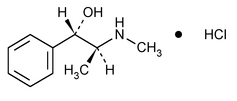Pseudoephedrine Hydrochloride
(soo'' doe e fed' rin hye'' droe klor' ide).
Benzenemethanol,
(+)-Pseudoephedrine hydrochloride
» Pseudoephedrine Hydrochloride contains not less than 98.0 percent and not more than 102.0 percent of C10H15NO·HCl, calculated on the dried basis.
Packaging and storage—
Preserve in tight, light-resistant containers.
Melting range, Class I  741
741 :
between 182
:
between 182 and 186
and 186 , but the range between beginning and end of melting does not exceed 2
, but the range between beginning and end of melting does not exceed 2 .
.
pH  791
791 :
between 4.6 and 6.0, in a solution (1 in 20).
:
between 4.6 and 6.0, in a solution (1 in 20).
Loss on drying  731
731 —
Dry it at 105
—
Dry it at 105 for 3 hours: it loses not more than 0.5% of its weight.
for 3 hours: it loses not more than 0.5% of its weight.
Residue on ignition  281
281 :
not more than 0.1%.
:
not more than 0.1%.
Chromatographic purity—
Use the chromatogram of the Assay preparation, obtained as directed in the Assay. Calculate the percentage of each impurity in the portion of Pseudoephedrine Hydrochloride taken by the formula:
100 (ri / rs)
in which ri is the response of the individual impurity; and rs is the sum of all the responses in the chromatogram: the sum of all the impurities found is not more than 2.0%.
Assay—
Triethylamine–phosphoric acid solution—
Mix 5 mL of triethylamine with 1 L of water. Adjust with phosphoric acid to a pH of 6.8.
Mobile phase—
Prepare a filtered and degassed mixture of Triethylamine–phosphoric acid solution and methanol (90:10). Make adjustments if necessary (see System Suitability under Chromatography  621
621 ).
).
System suitability solution—
Prepare a solution in water containing about 0.1 mg of USP Pseudoephedrine Hydrochloride RS and 0.002 mg of USP Ephedrine Sulfate RS per mL.
Standard preparation—
Dissolve an accurately weighed quantity of USP Pseudoephedrine Hydrochloride RS in water to obtain a solution having a known concentration of about 0.1 mg per mL.
Assay preparation—
Transfer about 100 mg of Pseudoephedrine Hydrochloride, accurately weighed, to a 100-mL volumetric flask, and dissolve in and dilute with water to volume. Dilute the solution, stepwise if necessary, to obtain a final concentration of 0.1 mg per mL.
Chromatographic system (see Chromatography  621
621 )—
The liquid chromatograph is equipped with a 206-nm detector and a 3.0-mm × 15-cm column that contains packing L11. The flow rate is about 0.6 mL per minute. Chromatograph the System suitability solution, and record the peak responses as directed for Procedure: the relative retention times are about 0.9 for ephedrine and 1.0 for pseudoephedrine; the resolution, R, between the pseudoephedrine and ephedrine peaks is not less than 2.0; the tailing factor for the pseudoephedrine peak is not more than 2.0; and the relative standard deviation for replicate injections is not more than 2.0%.
)—
The liquid chromatograph is equipped with a 206-nm detector and a 3.0-mm × 15-cm column that contains packing L11. The flow rate is about 0.6 mL per minute. Chromatograph the System suitability solution, and record the peak responses as directed for Procedure: the relative retention times are about 0.9 for ephedrine and 1.0 for pseudoephedrine; the resolution, R, between the pseudoephedrine and ephedrine peaks is not less than 2.0; the tailing factor for the pseudoephedrine peak is not more than 2.0; and the relative standard deviation for replicate injections is not more than 2.0%.
Procedure—
Separately inject equal volumes (about 10 µL) of the Assay preparation and the Standard preparation into the chromatograph, record the chromatograms, and measure the responses for the major peaks. Calculate the percentage of C10H15NO·HCl, in the portion of Pseudoephedrine Hydrochloride taken by the formula:
100 (CS / CU)(rU / rS)
in which CS and CU are the concentrations, in mg per mL, of pseudoephedrine hydrochloride in the Standard preparation and Assay preparation, respectively; and rU and rS are the peak responses obtained from the Assay preparation and the Standard preparation, respectively.
Auxiliary Information—
Please check for your question in the FAQs before contacting USP.
| Topic/Question | Contact | Expert Committee |
|---|---|---|
| Monograph | Clydewyn M. Anthony, Ph.D.
Senior Scientific Liaison 1-301-816-8139 |
(SM22010) Monographs - Small Molecules 2 |
| Reference Standards | RS Technical Services 1-301-816-8129 rstech@usp.org |
USP35–NF30 Page 4476
Pharmacopeial Forum: Volume No. 34(2) Page 298

